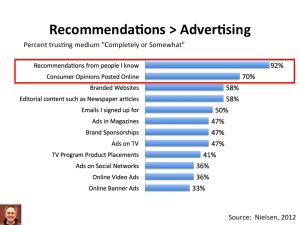Your brand is a set of emotions triggered by brain chemicals. Those chemicals are set off by the data points your customer knows about your brand. Social Media changes branding because it makes it much cheaper to produce and deliver those data points. However, it’s also easier for your competition. Cheaper message production and distribution mean it’s a much noisier space for all brands.
That means brands have to concentrate on:
- Defining where they want to compete
- Honestly assessing how the brand is perceived in that competitive space
- Developing a strategy to get the brand from where it is to where it should be
- Executing with best practices in a noisy space
Let’s walk through the process:
- Where to compete? This is a canonical strategy question, but particularly in the crowded social media space, there is a need to define the competitive space tightly in order to establish a sustainable base. Now that every brand is a media company, you have to think like a media company. Narrow and deep beats broad and shallow.The key points to define here are which segment the brand is seeking to reach, what success looks like, and the competitive scenario. Is this segment of the market crowded? How do buyers make decisions? What do people know about you? What do they know about your competitors? A simple 2×2 matrix can be a useful planning tool here for mapping the competition.
- Honestly assessing positioning. Once you have defined the competitive arena, where are you versus other choices, both competing propositions and substitutes? Most importantly, how do you stack up on Emotional Benefits and on Functional Benefits? The new tools allow you to create and curate many more messages than you could before, and you can craft them to emphasize the benefits of your choice. Based on where you need to be, where are you now? Do your buyers care about emotional benefits? Almost certainly, even if they’re B2B buyers. What emotions are you trying to evoke? The Plutchik wheel can be very valuable in articulating the emotions you are trying to evoke. Social listening and sentiment analysis tools can be very useful in gathering data for this analysis, as well as customer interviews and other traditional data-gathering tactics.What you’re looking for is an assessment of (a) what the market thinks about you and (b) how strongly they feel it. In most cases, they don’t feel strong at all. The emotional or functional benefits for brands are lost in the noise, and you will have an uphill climb. The ugly truth is that most buyers don’t think of you much at all. But to get onto a buyer’s shortlist, you will need to register on their radar screen. Regular buyers may have a strong sense of your functional benefits, but don’t expect the market to really understand the benefits of your feature set. The emotional benefits may be all over the map. IBM evoked very strong and clear emotions in the 1980’s. Those emotions are less clear now. Blackberry is another example—they stood for one thing ten years ago, and something very different today. Emotion is dynamic and context-based. It needs to be regularly monitored and managed as much as it can be.In most cases, brands will need to improve performance on both axes. Your functional benefits are not all that well understood and your emotional benefits may not be registering at all. An example for an agriculture and chemical company might be for a particular segment (not product buyers but the public at large) “Increase understanding of functional benefits A, B, and C” and “Move emotional profile weighting away from Fear and Disgust and toward Trust and Surprise.” A packaged goods company might aim for “Deepen understanding of our unique functional benefits, and focus emotional benefits toward Trust.”
- Charting a course. Now that you have determined where you need to be and where you are now, the course needs to be charted. There are different tools available, but there are significant differences in the degree to which they are trusted. As the chart shows, Recommendations from friends are the most trusted medium, but those recommendations can’t be easily bought. Should you base your entire strategy on them? You can buy all the banner ads you want, but will anybody believe you?
(Click the chart to expand)
There are three main dimensions to be managed:
- What sort of messages? Are the messages principally functional or emotional? What does the target market like? What is the competition doing? Is there a role model from another industry?
- What medium to use? What media will be the right levers to pull? In current practice, Functional benefits are best delivered via Blogs, White Papers, LinkedIn, and Twitter. Emotional benefits are well suited to Facebook, Instagram, Vine, YouTube, and Pinterest. Most importantly, where does your audience look for information? There’s no point crafting the right message strategy for a medium they don’t use. (Pinterest usage is almost 80% female.) Blogs can be the most useful because everyone uses Google, and Google loves fresh, relevant information.
- How to reach these audiences? How many people are you trying to each? Do you need to invest in paid audience building? Which tactics should you use? Do you expect people to share your messages voluntarily? Why?
4. Rigorous execution. The principal challenge most organizations have with social media is not developing the strategy or choosing the right channels. It’s executing remorselessly every day. Because most people now use social media for their own personal brands, it is easy to think of social media as intuitive. While it is easy to be a dilettante, best practices change quickly, and demand rigorous execution. This breaks down into two categories, and most companies are weak at both of them.
- Content. What are the best practices for a tweet? Where does the hashtag go? Is video better than infographic? Best practices in content creation are always evolving. Well established forms like Blogs and Twitter have achieved a certain level of canonical knowledge, but nowhere near print ads or even PPC advertising. The rules change rapidly, and you need to have a team in place who can create or curate relevant content with the best practices of the moment. It’s a very crowded marketplace (approaching perfect competition in many categories), and execution matters.
- Distribution. How many people a day should I follow on Twitter? Can I name someone in a tweet? Should I pay for Facebook ads? Which kind? How many times a day can I update LinkedIn before I start irritating people? Do I really have to update the blog every day? Can I just tweet links? If you do not effectively build distribution, your brand will become irrelevant. That distribution can come from owned media (your blog), earned media (other people talking about you, guest posts on other people’s blogs), or paid media (Promoted Twitter account). Different situations demand different media selection, but getting wide distribution in your target segment is a basic requirement of building your brand.
Based on this framework, brands can find themselves in one of four basic situations
- Brand Creation. Need to put new data points in market and need to build audience.
- Brand Turnaround. Audience exists but brand needs to be repositioned with that audience. Need to align messages with desired brand characteristics.
- Brand Growth. The right messages are in place, but Need to connect with more people.
- Brand Maintenance. Messages positioned correctly, audience is correct, but need to develop and expand both either generally or to support a new initiative
Social media lowers the bar so that everyone can compete in brand building, but advantages accrue to those who have a crisply defined sense of what they are trying to establish, and those who put adequate resources behind creating the right content and distributing it effectively. Too many brands put up a Facebook page and spin their wheels. But by rigorously defining and executing a strategy, you can use these tools to shape your brand for the modern age
Photo Credit: Flickr
Adrian Blake has worked with Saturday Night Live, McKinsey & Co., and The Progressive Farmer and is a founder of a Social Media agency.
Adrian Blake. Strategy. Social Media.




